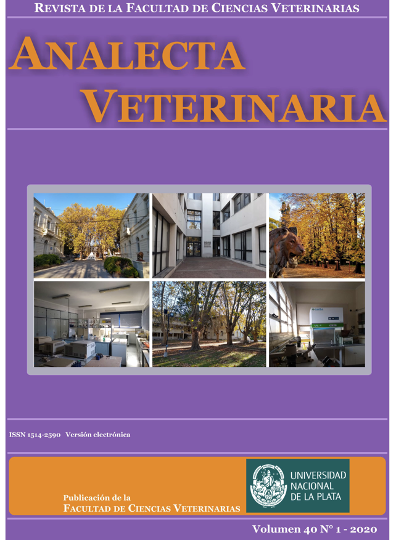Prevalencia del virus diminuto del ratón, determinada mediante una técnica de PCR semianidada, en ratones de experimentación de bioterios de Argentina
Virus diminuto del ratón en bioterios de Argentina
DOI:
https://doi.org/10.24215/15142590e046Palavras-chave:
virus diminuto del ratón, PCR, prevalenciaResumo
El virus diminuto del ratón puede producir alteraciones de los parámetros fisiológicos de los animales infectados, lo que hace que se modifiquen los resultados de aquellas experiencias en las que el ratón es utilizado como modelo experimental. Para poner en práctica medidas adecuadas de control del virus en bioterios, son necesarios métodos de detección eficientes, ya sea técnicas serológicas que ponen en evidencia la presencia de anticuerpos antivirales en el huésped, o técnicas moleculares como la PCR. El objetivo de este trabajo fue diseñar y poner a punto una técnica de PCR semianidada para la detección de ADN viral a partir de muestras de materia fecal y de bazo y, determinar, mediante esta técnica molecular, la prevalencia del virus en bioterios de Argentina. Diecinueve muestras de pools de heces (del 41,3 % de los bioterios) y 109 muestras de bazo (del 47,82 % de los bioterios) resultaron positivas. La prevalencia a partir del análisis total de las muestras de bazo fue estimada en 23,69 %. La técnica de PCR semianidada diseñada, constituye una herramienta molecular sensible y específica para realizar la detección del virus diminuto del ratón en instalaciones de animales de experimentación de Argentina.
Downloads
Métricas
Referências
Ball-Goodrich LJ, Hansen G, Dhawan R, Paturzo FX, Vivas-Gonzalez BE. 2002. Validation of an enzyme-linked immunosorbent assay for detection of mouse parvovirus infection in laboratory mice. Comparative Medicine. 52(2):160-6.
Bauer BA, Besch-Williford CL, Riley LK. 2004. Comparison of the mouse antibody production (MAP) assay and polymerase chain reaction (PCR) assays for the detection of viral contaminants. Biologicals. 32(4):177-82. https://doi.org/10.1016/j.biologicals.2004.08.004
Bauer BA, Riley LK. 2006. Antemortem detection of Mouse parvovirus and Mice minute virus by polymerase chain reaction (PCR) of faecal samples. Laboratory Animals. 40(2):144-52. https://doi.org/10.1258/002367706776319079
Besselsen DG, Pintel DJ, Purdy GA, Besch-Williford CL, Franklin CL, Hook RR Jr, Riley LK. 1996. Molecular characterization of newly recognized rodent parvoviruses. Journal General Virology. 77(5):899-911.
Besselsen DG, Romero MJ, Wagner AM, Henderson KS, Livingston RS. 2006. Identification of novel murine parvovirus strains by epidemiological analysis of naturally infected mice. Journal of General Virology. 87(Pt6):1543-56. https://doi.org/10.1099/vir.0.81547-0
Besselsen DG, Franklin CL, Livingston RS, Riley LK. 2008. Lurking in the shadows: emerging rodent infectious diseases. Institute for Laboratory Animal Resources Journal. 49(3):277-90. https://doi.org/10.1093/ilar.49.3.277
Blank WA, Henderson KS, White LA. 2004. Virus PCR assay panels: an alternative to the mouse antibody production test. Laboratory Animals (NY); 33(2):26-32. https://doi.org/10.1038/laban0204-26
Bonnard GD, Manders EK, Campbell DA Jr, Herberman RB, Collins MJ Jr. 1976. Immunosuppressive activity of a subline of the mouse EL-4 lymphoma. Evidence for Minute virus of mice causing the inhibition. Journal of Experimental Medicine. 143(1):187-205. https://doi.org/10.1084/jem.143.1.187
Bootz F, Sieber I, Popovic D, Tischhauser M, Homberger FR. 2003. Comparison of the sensitivity of in vivo antibody production tests with in vitro PCR-based methods to detect infectious contamination of biological materials. Laboratory Animals. 37(4):341-51. https://doi.org/10.1258/002367703103051895
Carter JB, Saunders VA. 2007. Parvoviruses (and other ssDNA viruses). En: Virology: Principles and applications. West Sussex (England), John Wiley & Sons Ltd., pp. 137-46.
Chang A, Havas S, Borellini F, Ostrove JM, Bird RE. 1997. A rapid and simple procedure to detect the presence of MVM in conditioned cell fluids or culture media. Biologicals. 25(4):415-9. https://doi.org/10.1006/biol.1997.0110
Clifford CB, Watson J. 2008. Old enemies, still with us after all these years. Institute for Laboratory Animal Resources Journal. 49(3):291-302. https://doi.org/10.1093/ilar.49.3.291
Compton SR, Riley LK. 2001. Detection of infectious agents in laboratory rodents: traditional and molecular techniques. Comparative Medicine. 51(2):113-9.
Crawford LV. 1966. A Minute virus of mice. Virology. 29(4):605-12. https://doi.org/10.1016/0042-6822(66)90284-4
Crawford LV, Follett EA, Burdon MG, McGeoch DJ. 1969. The DNA of a minute virus of mice. Journal of General Virology. 4(1):37-46. https://doi.org/10.1099/0022-1317-4-1-37
Engers HD, Louis J, Zubler Jand Hirt B. 1981. Inhibition of t cell-mediated functions by MVM(i), a parvovirus closely related to the Minute Virus of Mice. Journal of Immunology. 127(6):2280-5.
Gilioli R, Sakurada JK, Andrade LA, Kraft V, Meyer B, Rangel HA. 1996. Virus infection in rat and mouse colonies reared in Brazilian animal facilities. Laboratory Animal Science. 46(5):582-4.
Goto K, Hayashimoto N, Ishida T, Takakura A, Kagiyama N. 2009. First trial in the developmental phase of the "performance evaluation program" based on the ICLAS animal quality network program: self-assessment of microbiological monitoring methods using test samples supplied by International Council for Laboratory Animals Science. Experimental Animals. 58(1):47-52. https://doi.org/10.1538/expanim.58.47
Hartley JW, Rowe WP. 1960. A new mouse virus apparently related to the adenovirus group. Virology. 11:645-7. https://doi.org/10.1016/0042-6822(60)90109-4
Institute for Laboratory Animal Resources (ILAR). 1976. Long term holding of laboratory rodents. A report of the Committee on Long-term Holding of laboratory rodents. ILAR News. 19 (4) L1-L25.
Janus L, Bleich A. 2012. Coping with parvovirus infections in mice: health surveillance and control. Laboratory Animals. 46(1):14-23. https://doi.org/10.1258/la.2011.011025
Janus LM, Mähler M, Köhl W, Smoczek A, Hedrich HJ, Bleich A. 2008. Minute virus of mice: antibody response, viral shedding, and persistence of viral DNA in multiple strains of mice. Comparative Medicine. 58(4):360-8.
Janus LM, Smoczek A, Jorns A, Hedrich HJ, Bleich A. 2010. Presence of minute virus of mice in immunocompetent mice despite the onset of host immunity. Veterinary Microbiology. 146(1-2):51-8. https://doi.org/10.1016/j.vetmic.2010.04.021
Kapil, S. 1995. Minute Virus of Mice (MVM) nucleic acid production in susceptible and resistant strains of mice and F1 hybrids. Comparative immunology, microbiology and infection diseases. 18(4):245-52. https://doi.org/10.1016/0147-9571(95)00016-2
Kunita S, Chaya M, Hagiwara K, Ishida T, Takakura A, Sugimoto T, Iseki H, Fuke K, Sugiyama F, Yagami K. 2006. Development of ELISA using recombinant antigens for specific detection of mouse parvovirus infection. Experimental Animals. 55(2):117-24. https://doi.org/10.1538/expanim.55.117
Laborde JM. Estudio de la prevalencia de infecciones producidas por el Virus Diminuto del Ratón (MVM) en bioterios de Argentina y su influencia en la contaminación de tumores trasplantables. 2017. Tesis de Doctorado. Facultad de Ciencias Veterinarias. Universidad Nacional de La Plata. Disponible en: http://sedici.unlp.edu.ar/bitstream/handle/10915/61115/Documento_completo.pdf-PDFA1b.pdf?sequence=1&isAllowed=y
Laborde JM, Sguazza H, Fuentealba N, Corva S, Carbone C, Galosi, C. 2017. Indirect ELISA (iELISA) for routine detection of antibodies against Minute Virus of Mice (MVM) in mice colonies. Revista Argentina de Microbiología. 49(3):210-5. https://doi.org/10.1016/j.ram.2017.02.005
Livingston RS, Riley LK. 2003. Diagnostic testing of mouse and rat colonies for infectious agents. Laboratory Animals. 32(5):44-51. https://doi.org/10.1038/laban0503-44
Macy JD, Cameron GA, Smith PC, Ferguson TA, Compton SR. 2011. Detection and control of mouse parvovirus. Journal of the American Association Laboratory Animal Science. 50(4):516-22.
Mahler M, Nicklas W. 2004. Health monitoring. En: Hedrich H, Bullock G, Petrusz P (eds). The laboratory mouse. Hannover (Alemania), Elsevier Academic Press. pp. 449-62.
Mahler M, Berard M, Feinstein R, Gallagher A, Illgen-Wilcke B, Pritchett-Corning K, Raspa B. 2014. FELASA recommendations for the health monitoring of mouse, rat, hamster, guinea pig and rabbit colonies in breeding and experimental units. Laboratory Animals. 48(3):178-92. https://doi.org/10.1177/0023677213516312
McMaster GK, Beard P, Engers HD, Hirt B. 1981. Characterization of an immunosuppressive parvovirus related to the minute virus of mice. Journal of Virology. 38(1):317-26.
Nicklas W, Baneux P, Boot R, Decelle T, Deeny AA, Fumanelli M, Illgen-Wilcke B. 2002. FELASA (Federation of European Laboratory Animal Science Associations Working Group on Health Monitoring of Rodent and Rabbit Colonies). Recommendations for the health monitoring of rodent and rabbit colonies in breeding and experimental units. Laboratory Animals. 36(1):20-42. https://doi.org/10.1258/0023677021911740
Pritchett-Corning KR, Cosentino J, Clifford CB. 2009. Contemporary prevalence of infectious agents in laboratory mice and rats. Laboratory Animals. 43(2):165-73. https://doi.org/10.1258/la.2008.008009
Redig AJ, Besselsen DG. 2001. Detection of rodent parvoviruses by use of fluorogenic nuclease polymerase chain reaction assays. Comparative Medicine. 51(4):326-31. Erratum in: Comparative Medicine 2003.52(2): following table of contents.
Schoondermark-van de Ven EM, Philipse-Bergmann IM, van der Logt JT. 2006. Prevalence of naturally occurring viral infections, Mycoplasma pulmonis and Clostridium piliforme in laboratory rodents in Western Europe screened from 2000 to 2003. Laboratory Animals. 40(2):137-43. https://doi.org/10.1258/002367706776319114
Shek WR, Paturzo FX, Johnson EA, Hansen GM, Smith AL. 1998. Characterization of mouse parvovirus infection among BALB/c mice from an enzootically infected colony. Laboratory Animal Science. 48(3):294-7.
Shek WR, Pritchett KR, Clifford CB, White WJ. 2005. Large-scale rodent production methods make vendor barrier rooms unlikely to have persistent low-prevalence parvoviral infections. Contemporary Topics Laboratory Animal Science. 44(4):37-42.
Toolan, H. 1990. The rodent parvoviruses. En: Tijssen p (ed.). 1990. Handbook of Parvoviruses. Volume II. Boca Raton (EE.UU.), CRC Press, pp. 159-76.
Ueno Y, Iwama M, Ohshima T, Sugiyama F, Takakura A, Itoh T, Yagami K. 1998. Prevalence of "Orphan" parvovirus infections in mice and rats. Experimental Animals. 47(3):207-10. https://doi.org/10.1538/expanim.47.207
Zhang DQ, Guo Q, Zhu JH, Chen WC. 2013. Increase of cyclooxygenase-2 inhibition with celecoxib combined with 5-FU enhances tumor cell apoptosis and antitumor efficacy in a subcutaneous implantation tumor model of human colon cancer. World journal of surgical oncology. 11:16. https://doi.org/10.1186/1477-7819-11-16
Zhan D, Roy MR, Valera C, Cardenas J, Vennari JC, Chen JW, Lui S. 2002. Detection of Minute virus of mice using real time quantitative PCR in assessment of virus clearance during the purification of mammalian cell substrate derived biotherapeutics. Biologicals. 30(4):259-70. https://doi.org/10.1006/biol.2001.0284
Publicado
Como Citar
Edição
Seção
Licença
Los autores/as conservan los derechos de autor y ceden a la revista el derecho de la primera publicación, con el trabajo registrado con la licencia de atribución de Creative Commons, que permite a terceros utilizar lo publicado siempre que mencionen la autoría del trabajo y a la primera publicación en esta revista.

Analecta Veterinaria por Facultad de Ciencias Veterinarias se distribuye bajo una Licencia Creative Commons Atribución-NoComercial-SinDerivar 4.0 Internacional.



























